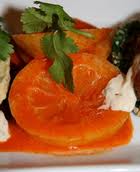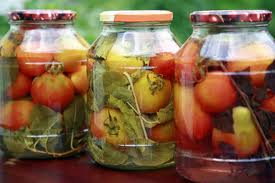Please note: The Orthodox Union makes no endorsements or representations regarding kashrut certification of various products/vendors referred to in Chef Shaya Klechevsky’s articles, blog, or web site.
 I caught glimpses into the world of canning and preservation from my grandmothers. I learned that since no chemical preservatives were added to the jams, it was of utmost importance to make sure that the jars and lids were thoroughly disinfected – a process, I discovered, made tremendously easier with dish washing machines – which traditionally meant boiling them in water and then only handling them with tongs or gloved hands (both grandmothers were queens of reusing jars from various products; I never remember them buying jars just for these purposes). As a kid, I remember indulging in delicious foods like homemade pickles, apricot and strawberry jam, and probably my most favorite, and most coveted amongst my family, cherry liqueur (I wasn’t allowed to have the alcoholic stuff until I was much older, so a non-alcoholic and cloyingly sweet syrup of cherries was my favorite digestif for when I behaved). Unsurprisingly, it was my grandmothers who produced these fine delicacies. Of course, there’s nothing remarkable in these products themselves, yet as a child, I only held the highest regard for them, and as I grew, came to realize how special they really were and appreciated these homemade versions of products that, until then, I took for granted as so commercially available.
I caught glimpses into the world of canning and preservation from my grandmothers. I learned that since no chemical preservatives were added to the jams, it was of utmost importance to make sure that the jars and lids were thoroughly disinfected – a process, I discovered, made tremendously easier with dish washing machines – which traditionally meant boiling them in water and then only handling them with tongs or gloved hands (both grandmothers were queens of reusing jars from various products; I never remember them buying jars just for these purposes). As a kid, I remember indulging in delicious foods like homemade pickles, apricot and strawberry jam, and probably my most favorite, and most coveted amongst my family, cherry liqueur (I wasn’t allowed to have the alcoholic stuff until I was much older, so a non-alcoholic and cloyingly sweet syrup of cherries was my favorite digestif for when I behaved). Unsurprisingly, it was my grandmothers who produced these fine delicacies. Of course, there’s nothing remarkable in these products themselves, yet as a child, I only held the highest regard for them, and as I grew, came to realize how special they really were and appreciated these homemade versions of products that, until then, I took for granted as so commercially available.
Of course, that’s only the preparation stage. Once the jams were placed in their receptacles, additional steps were taken to ensure a long and healthy shelf life. One grandmother found that a plastic wrap layer on top was useful, the other didn’t even think about it – I chalk that up to variation. However, the next most important step I learned was to make sure that only clean metal spoons were to be used in serving up the jam, and once used not to be returned back into the jar. At first, I just didn’t understand. Why not? I mean, I repeatedly used the same spoon or knife when helping myself to (heaping) servings of Smucker’s® or Polaner® All-fruit preserves, oftentimes in between dipping into peanut butter with the very same spoon or knife. This practice is absolutely sacrilegious with homemade jams, the reason being that without the addition of chemical preservatives, there is very little in the way of preventing mold and/or bacterial growth from occurring. Therefore, it was important not to introduce a non-sterile utensil into the jar.
I’ve alluded to canning and preserving in some of my previous articles, particularly in reference to the CSAs (note: Attention Locavores: Community Supported Agriculture and Jewish CSA: The Perfect Shidduch), and I’m finding the resurgence and interest in these techniques exciting and a natural progression to living a greener lifestyle. Pickling, preserving and canning all came about as a means of stretching out seasonal foods that you had in abundance or as a means of having these foods when they are no longer in season, or even during a season when food was less available. In fact, the argument can be made that the invention or discovery of cheese was also a means of preserving milk and extending that particular nutrient source’s shelf-life (the history dates back to when they used animal skins and stomachs to hold liquids, and one day they put milk in it and the enzymes that are naturally occurring in the animal skins and stomach turned the milk into curds and whey or cheese).
Today, with the high interest in buying at farmer’s markets or even buying shares in a CSA program, the notion of preserving and really stretching out what you have is becoming more popular. Canning is economical; it helps the dollar go farther on the food stuff you buy and is relatively inexpensive.
Different foods have different preserving methods, and there are many different recipes on the internet for different types of preserved foods. For example, there are a ton of online recipes for pickles of every sort, and some even go into the detail and science of the pickling liquid, as well as the ratio of liquid to solids and pickling time. You can also find lots of delicious recipes for fruit preserves or jams, many of which are very easy to create, though other types of fruit may require some help with the addition of pectin (a natural fruit binder/thickener/gelling agent).
Of course, once you find the recipe of choice, the canning of the finished product more or less remains the same. Some tips to keep in mind:
- Keep a Sterile Environment – this is of utmost importance. The last thing you want to do is create an environment for molds and bacteria (that naturally exist in our environment) to get in and have a field day, and essentially spoil the very food you were hoping to preserve. This means making sure that the jars you use are sterilized either through boiling or running through the dish washing machine (sometimes both) before you use them. Additionally, it’s important to re-boil the jars once you have filled and sealed them both to kill any remaining spoiling agents (mold/bacteria) as well as to create a hermetic seal to prevent new spoiling agents from getting in.
- Make sure to choose the right size/shape of jar for the type of preserving you plan on doing – especially if you plan on freezing the jar later. For example, wide-mouthed jars are better suited to whole fruits or vegetables or even juices, whereas a regular-mouthed jar is better suited for jams, chutneys, condiments and sauces. You may also want to consider the size of the jars as it relates to the total amount of preserving product. It may make sense to have more small jars than fewer large jars. This largely depends on how much of the preserves you will consume once you open and break the seal, since you will have to refrigerate it immediately after opening.
The National Center for Home Food Preservation is a wonderful website that provides all sorts of information regarding canning and preserving food. The site, in conjunction with the US Department of Agriculture, is a comprehensive resource on both food preservation recipes (like pickles and jams) as well as various canning techniques and tips on how to choose the right canning receptacle as well as the best storage environment.
While this may seem like a lot, once you get into the groove of canning, it really becomes a fun and great way of living a healthier, greener and more economical lifestyle. This activity, when monitored properly, is also a wonderful way of getting your children involved and in the kitchen. Soon, they too will have fond memories to share of their childhood of delicious foods cooked up by their parents.
 Paprika Preserved Lemons
Paprika Preserved Lemons
Ingredients:
- 1 Tablespoon spicy or smoked paprika
- 1 Tablespoon sweet paprika
- 1 Tablespoon Salt
- 4 lemons, for pickling
- Blended olive oil
- 3 lemons, for juice
- Jar for pickling
Instructions:
- Combine the 2 paprikas and salt together in a shallow bowl.
- Wash each lemon thoroughly with soap and water, and dry the lemons for pickling.
- Cut off the 2 ends of the lemons, and then slice rings approximately ¼-inch thick.
- Dip each slice of lemon into the spice rub, making sure to liberally cover both sides of each slice.
- Layer each slice inside the pickling jar.
- In between each layer of sliced lemons, pour a thin layer of the blended olive oil.
- When jar is completely filled, squeeze fresh lemon juice to fill about halfway up the sides of the jar.
- Allow this mixture to sit unrefrigerated for at least 3 days, making sure to turn the jar upside-down each day in order to re-distribute the juices.
- Continue pickling the lemons, refrigerated, for another 4 – 11 additional days, ensuring to continue flipping the jar daily.
NOTE: Blended Olive Oil is an olive oil that is blended from NON First Cold Press Oil (aka Extra Virgin Olive Oil) or Second Cold Press Oil (Virgin Olive Oil). Blended olive oil usually has a more neutral flavor and is generally less expensive than the first two varieties. You can find a variety of available OU blended olive oils in the OU Kosher Product Search. A good alternative is vegetable oil.
Certain produce requires careful examination and scrutiny for any bugs and insects. For more information, please visit : OU Fruit and Vegetable Inspection Chart
Browse through the OU’s growing collection of nearly 3000 recipes by visiting: OU Kosher & Holiday Recipes
Chef Shaya Klechevsky grew up in a home rich in diverse cultures; his mother, an Egyptian native, and his father, a Polish native, brought an interesting mix of food and flavor to every meal. Fostered by his upbringing, after attending Brooklyn College where he achieved a Bachelors of Arts in Psychology with a minor in Health & Nutrition Sciences, Chef Shaya found his way to the French Culinary Institute at the International Center for Culinary Arts in New York City’s vibrant SoHo. There, he learned the secrets to French cooking and fused his classic training with his background in Middle Eastern/Mediterranean and Eastern European cuisine resulting in a flavorful combination of ingredients. He has a passion for good food and a healthy lifestyle, bringing healthy, kosher, gourmet cuisine to his clients. For more information, please visit Chef Klechevsky’s website: At Your Palate.
The words of this author reflect his/her own opinions and do not necessarily represent the official position of the Orthodox Union.
